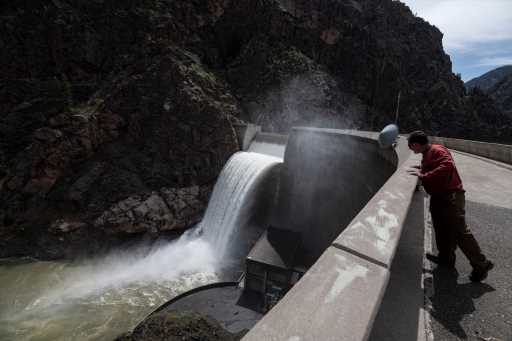Billions of gallons of water are rushing this week out of the Blue Mesa Reservoir on Colorado’s Western Slope, through the Black Canyon of the Gunnison and ultimately into the Colorado River.
For the first time in a few years, Colorado has had enough water to spare. Officials at the U.S. Bureau of Reclamation have turned up the faucet at Blue Mesa for an eight-day release that began last week and will gradually increase in volume until Thursday when it ends.
At any given moment, thousands of cubic feet are flowing through the series of three dams that make up the Blue Mesa Reservoir system. At the release’s peak, the dams will release about 7,200 cubic feet of water – nearly 54,000 gallons – per second.
“That’s what’s going by every single second,” Grant Watson, plant supervisor at the Crystal Dam and Power Plant, said. “Not a day, not an hour, but every second.”
That much water could fill nearly five Olympic swimming pools within a minute.
Colorado received so much snow this winter that reservoirs across the state are, by and large, filling higher than they have been in recent years and officials at Reclamation are able to send even more water downstream.
While all of this water is a pleasant surprise for the drought-stricken American West, it’s only a stopgap to the region’s water woes.
Colorado’s reservoirs can only hold so much water, at best enough for a couple of really dry years, Jason Ullmann, deputy state engineer with the state’s Division of Water Resources, said. So while the Western Slope enjoys a wetter-than-anticipated spring and summer, people shouldn’t allow themselves to be lulled into a false sense of security, he said.
The Colorado River Basin is still drying. A longstanding drought has been made worse and permanent by climate change.
For now, however, state and federal water managers must handle a substantial spring runoff. Denver Water’s Dillon Reservoir (the utility’s largest) currently sits at 81% full and rising. The same goes for Horsetooth Reservoir, which provides drinking and irrigation water in northern Colorado and sits at 85% full.
Blue Mesa Reservoir – which, for context, has more than three times Dillon’s capacity – is currently at 55.86% full with more water flowing in every day. Unlike many of the state’s other reservoirs, though, Blue Mesa doesn’t specifically serve cities and farms (like Dillon and Horsetooth reservoirs do). Its water is effectively owned and managed by the U.S. Bureau of Reclamation, John McClow, general council for the Upper Gunnison River Water Conservancy District, said.
The federal reservoir is part of a larger system, called the Colorado River Storage Project, which also includes Lake Powell (the country’s second-largest reservoir), Flaming Gorge Reservoir in Wyoming and Utah and Navajo Reservoir in New Mexico and southern Colorado.
That project is meant to help upper Colorado River Basin states – Colorado, New Mexico, Utah and Wyoming – ensure they can send as much water downstream to lower basin states – Arizona, California and Nevada – as required by law, McClow said.
“It’s a big bank account,” he said.
Federal officials can – and have – ordered upstream reservoirs to release massive quantities of water to prop up levels at the foundering Lake Powell.
But that’s not the purpose of this year’s releases, Erik Knight, a hydrologist with Reclamation, said. Aside from providing Powell with water, the system is also required to send a certain amount downstream during wet years to mimic natural conditions along the waterways.
More specifically, this type of release is designed to protect endangered fish in the Gunnison River near Whitewater, southeast of Grand Junction, Knight said. Those species include the Colorado pikeminnow, Razerback sucker, the Humpback chub and the Bonytail chub, Knight said.
The releases must go through a series of three dams that serve as part of the Blue Mesa Reservoir system. They are the Blue Mesa, Crystal and Morrow Point dams and together they’re called the Aspinall Unit.
Similar releases took place in 2019, 2017, 2014 and 2011, Knight said.
All told, the amount of water released from Blue Mesa will likely be 60,000 acre-feet, perhaps higher, which will eventually flow into Lake Powell, Knight acknowledged.
That’s a relatively small amount compared to Powell’s storage capacity of more than 24 million acre-feet.
If the releases were mainly to help keep Lake Powell afloat Ullmann said state officials would take issue with them. But Reclamation owns the rights to water in Blue Mesa and as long as they’re not wasting water the state doesn’t interfere.
As conditions across the state stand, releases out of Blue Mesa don’t preclude other reservoirs from collecting their own water, Dave Kanzer, director of science and interstate matters for the Colorado River District, said.
Plus, even after releasing this water, Blue Mesa might still fill or get close to it, meaning the reservoir would have had to let out water anyway to keep from overfilling, Knight said.
“It’d have to go out anyway, we can’t keep it in there,” Knight said.
Source: Read Full Article



